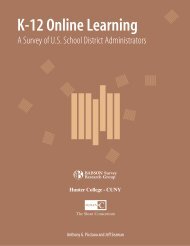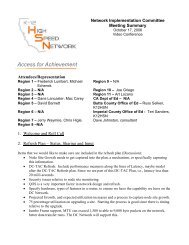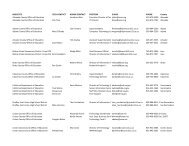Statewide Network Comparison: Overview - K12HSN
Statewide Network Comparison: Overview - K12HSN
Statewide Network Comparison: Overview - K12HSN
Create successful ePaper yourself
Turn your PDF publications into a flip-book with our unique Google optimized e-Paper software.
Appendix A<br />
Executive Summary<br />
The California K12 High Speed <strong>Network</strong>:<br />
Developing a Service Model<br />
Marcie J. Bober, Ph.D.<br />
Jonathan Leavitt, M.A.<br />
Rhea Borysiak-Fix, M.A.<br />
Department of Educational Technology<br />
San Diego State University<br />
May 2005
APPENDIX A: Summary of High Speed <strong>Network</strong>s (Educational) by State<br />
Prepared by Jonathan Leavitt, MA<br />
Dept. of Educational Technology, San Diego State University<br />
State HSN initiative and link to site Size or impact on state<br />
(as described on program sites)<br />
Alabama<br />
Alabama Research and Education <strong>Network</strong><br />
(AREN)<br />
http://www.asc.edu/network/index.shtml<br />
Approximately 150 client institutions are connected to AREN, including all public<br />
universities and colleges, the state's community colleges, several state<br />
government agencies, nine K-12 regional training centers, and approximately 40<br />
K-12 school systems. For those universities which have an alternate primary<br />
Internet service provider, AREN functions as a secondary ISP for local traffic and<br />
the primary route for traffic within the state.<br />
Participants: State government, four year universities, two year colleges, and k-<br />
12 schools<br />
Alaska<br />
Arizona<br />
Arkansas<br />
California<br />
Information Technology Group (ITG)<br />
http://www.state.ak.us/itg/<br />
Telecommunications Open Partnerships for<br />
Arizona (TOPAZ)<br />
http://gita.state.az.us/tech_news/2001/9_25_01<br />
_news_release.htm<br />
Arkansas Academic and research <strong>Network</strong><br />
(ArkNet)<br />
http://www.uark.edu/staff/arknet/<br />
OC-3 Backbone – 155mb/s<br />
Started out being maintained by University of<br />
Arkansas and then in 1998 it was turned over<br />
to the Arkansas Department of Information<br />
Systems<br />
CalREN<br />
http://www.cenic.org/<br />
K-12 High Speed <strong>Network</strong><br />
http://www.k12hsn.org/<br />
ITG maintains a multi-protocol backbone WAN that connects LANs in<br />
Anchorage, Fairbanks and Juneau. Agency connections are made via leased<br />
line or dial-in to the regional backbone hub. Several other locations have<br />
dedicated connections. The ITG WAN has Internet addresses available to hook<br />
into national and international networks.<br />
TOPAZ was created by the state’s Government Information Technology Agency<br />
(GITA) to expand broadband usage throughout Arizona. Originally intended to<br />
connect the top 87 communities by population in the state, 126 communities<br />
have been linked since 2001.<br />
The initial ARKnet network consisted of point-to-point 56K circuits from each<br />
institution to one of the two central network nodes located in Fayetteville and<br />
Little Rock. Internet access in the beginning was through the MIDnet regional<br />
network (later to become Global Internet, which later was bought out by Verio).<br />
As the network grew and bandwidth needs increased, the entire ARKnet network<br />
was rebuilt using frame relay services provided by Southwestern Bell. As the T1<br />
lines at the central routing nodes became saturated, they were replaced by<br />
Southwestern Bell ATM OC-3 circuits and frame interworking. Eventually, the six<br />
T1 lines to Verio were overwhelmed by the state's traffic, so the state network<br />
contracted with Southwestern Bell Internet Services (SBIS) for new highbandwidth<br />
(OC-3) Internet service. Today, the state network has an internal<br />
backbone consisting of multiple OC-3 circuits and two Internet service providers<br />
(SBIS in Little Rock, and Qwest Communications in Fayetteville).<br />
CalREN-DC, CENIC's Digital California network, provides high-quality network<br />
services for K-20 students/teachers/staff and for faculty, researchers and staff at<br />
higher education institutions. CENIC's support of K-12 networking extends the<br />
existing CalREN backbone to each of the 58 California counties to facilitate<br />
connectivity by California's K-12 schools.
APPENDIX A: Summary of High Speed <strong>Network</strong>s (Educational) by State<br />
Prepared by Jonathan Leavitt, MA<br />
Dept. of Educational Technology, San Diego State University<br />
State HSN initiative and link to site Size or impact on state<br />
(as described on program sites)<br />
fiber optics – currently 2.5 gigabytes<br />
Initially managed by CENIC and now, after a<br />
competitive process, is overseen by the<br />
Imperial County Office of Education (in<br />
partnership with the Butte and Mendocino<br />
COEs).<br />
In addition to providing the entire California research and education community<br />
with the most cost-effective advanced services network available, the multi-tiered<br />
CalREN infrastructure supplies high-level network services needed to<br />
successfully conduct high-performance research activities. It also provides<br />
network researchers in California with the infrastructure needed to conduct<br />
critical investigations into optical networking technology.<br />
Participants: Higher Education Research/K20 Internet 1 and 2<br />
Connecticut<br />
Connecticut Education <strong>Network</strong><br />
http://www.ct.gov/cen/site/default.asp<br />
fiber optics - 1 Gigabit to start with<br />
Started in 2000, projected completion – 2005.<br />
Run by the State Department of Information<br />
Technology and a partnership with the<br />
University of Connecticut.<br />
The Connecticut Education <strong>Network</strong> (CEN) is America's first statewide K12 and<br />
higher education network to be built exclusively using state-of-the-art fiber optic<br />
connections. Operating at speeds 1000 times faster than a home<br />
broadband connection, the CEN provides incredible access to the Internet, the<br />
next generation Internet2, the Connecticut Digital Library, and thousands of other<br />
resources exclusively targeted to students, teachers, researchers and<br />
administrators in Connecticut's education institutions.<br />
Upon completion in summer, 2005, every K12 and Higher Education connection<br />
to the CEN will have a fiber optic based connection that will allow high speed<br />
multimedia learning tools, research activities and online administrative activities<br />
in every school district and on every campus in the State. Many public libraries<br />
are also being connected to the network.<br />
Participants: Public K-12, public/private higher ed, libraries<br />
Georgia<br />
Peachnet<br />
http://www.usg.edu/peachnet/<br />
Could not find a good description.<br />
Hawaii<br />
Could not locate.<br />
Illinois****<br />
Illinois Century <strong>Network</strong> (ICN)<br />
http://www.illinois.net/about/default.htm<br />
Connects to the Internet and Internet2 at<br />
speeds of OC-12 or higher (622 mb/s). The<br />
entire backbone consists of DS-3 (45 Mb/s)<br />
circuits or higher. Website states that it offers 1<br />
Provides a world-class IP network to over 6,100 educational institutions - more<br />
than any other network of its kind in the United States or the world<br />
Serves approximately 2 million Illinois citizens - mostly students<br />
Passes between 600 and 800 million bits per second to the Internet on a daily
APPENDIX A: Summary of High Speed <strong>Network</strong>s (Educational) by State<br />
Prepared by Jonathan Leavitt, MA<br />
Dept. of Educational Technology, San Diego State University<br />
State HSN initiative and link to site Size or impact on state<br />
(as described on program sites)<br />
Gigabit per second of Internet service<br />
basis<br />
Indiana<br />
Iowa****<br />
Started by the Illinois State Board of Education<br />
to serve K-12 schools in 1995. ICN was<br />
formed by PA 91-21 and signed into law on<br />
June 8, 1999. ICN built upon existing<br />
frameworks which included: Illinois Higher<br />
Education Video <strong>Network</strong>, the Illinois State<br />
Board of Education’s Internet initiative, the<br />
Illinois State Library’s work to connect libraries<br />
with learners, and efforts of the Department of<br />
Central Management Services to provide<br />
statewide telecommunications links.<br />
Indiana Telecommunications <strong>Network</strong><br />
http://www.in.gov/itn/<br />
I-Light2<br />
http://www.in.gov/itn/members/images/I_Light_<br />
2.pdf<br />
ITN currently provides 700 Mb/s access to the<br />
commercial Internet.<br />
I-Light2 is currently under construction but will<br />
provide a fiber optics backbone across the<br />
state.<br />
Iowa Communications <strong>Network</strong> (ICN)<br />
http://www.icn.state.ia.us/index.html<br />
Fiber optics ring network currently delivering up<br />
to 400 Mb/s.<br />
Also includes a state-wide ATM network which<br />
enables full motion video.<br />
Started in 1989 when the state legislature<br />
passed a bill for the construction of a state<br />
telecommunications network. Continued to be<br />
Has the largest bandwidth available to any community college system in the<br />
United States<br />
Is the first state network to become fully multicast enabled allowing a single<br />
stream of video to be replicated at an institution providing access to broadcast<br />
quality video transmissions including channels and productions from CSPAN,<br />
PBS, NASA, Department of Defense, the Smithsonian Institution, and hundreds<br />
of others.<br />
Participants: Schools, museums, libraries, local government and communities<br />
(See FAQ list for more info – excellent materials on website)<br />
ITN makes a critical impact on the way educational, governmental, public, and<br />
social services are delivered and administered in the state. It currently connects<br />
nearly 2,000 local and state government offices, public libraries, K-12 schools,<br />
learning centers, County Extension Services, Indiana higher education<br />
institutions, and other public sector users.<br />
I-Light2 will build on the success of I-Light, Internet2, and ITN to expand and link<br />
the State’s networking efforts. It will expand the fiber optic network of I-Light and<br />
link to the 2000 ITN users around the state.<br />
Recognizing the value of a high speed network, the Indiana legislature approved<br />
I-Light2 funding with a $10 million appropriation in the 2003 Budget Bill.<br />
Participants: K-12 schools, higher education, public libraries, state government,<br />
and public broadcasting<br />
<strong>Statewide</strong> fiber optics network linking k-12 schools, universities, libraries, and<br />
hospitals. Currently offers up to 400mbps and full motion video and audio<br />
services.<br />
Participants: Hospitals, state and federal government, public defense armories,<br />
libraries, schools, and higher education<br />
(See website for more info – excellent material)
APPENDIX A: Summary of High Speed <strong>Network</strong>s (Educational) by State<br />
Prepared by Jonathan Leavitt, MA<br />
Dept. of Educational Technology, San Diego State University<br />
State HSN initiative and link to site Size or impact on state<br />
(as described on program sites)<br />
state-funded and construction was completed<br />
in phases.<br />
Kansas<br />
Kentucky<br />
Louisiana<br />
Maine<br />
Kansas Research and Education <strong>Network</strong><br />
(KanREN)<br />
http://www.kanren.net/<br />
non-state-owned star network. Appears that<br />
network has been upgraded and delivers<br />
gigabit speeds. Backbone material is<br />
unknown.<br />
Kentucky Information Highway (KIH)<br />
http://ky.gov/got/kih/<br />
Louisiana <strong>Network</strong> (LaNet)<br />
http://www.state.la.us/otm/lanet/index.htm<br />
state sponsored and managed, star network<br />
delivering backbone speeds of 45 – 155 Mb/s.<br />
(DS-3 and Oc-3 circuits)<br />
Maine School and Library <strong>Network</strong> (MSLN)<br />
http://www.msln.net/<br />
KanREN is a non-profit consortium of colleges, universities, school districts and<br />
other organizations in Kansas, organized for the purpose of facilitating<br />
communication among them, and providing themselves with connectivity to the<br />
Internet via a statewide TCP/IP network.<br />
Participants: Hospitals, libraries, schools and higher education<br />
Started in 1995. Today, over 3,000 sites are inter-connected across the state -<br />
1,200 schools, and all 176 school districts, libraries, local government and health<br />
departments.<br />
The statewide network, with an "access ramp" in every one of Kentucky's 120<br />
counties.<br />
Participants: Government, Education and research users<br />
The Office of Telecommunications Management (OTM) was formed by Act 1098<br />
during the 1997 Regular session to oversee telecommunications systems for<br />
Louisiana’s citizens.<br />
Participants: Any political subdivision of the State of Louisiana, including city and<br />
parish government. Private and public educational institutions within the State of<br />
Louisiana from kindergarten through university level<br />
Although many articles exist touting the size and impact of Maine’s fiber optics<br />
infrastructure currently in place, no single source can be found at this time that<br />
describes their High Speed initiative. It appears to be aimed at attracting<br />
businesses to the region.<br />
Massachusetts****<br />
Massachusetts Information Turnpike Initiative<br />
(MITI)<br />
http://www.umassmiti.net/generic.cfm?code=djklwe8<br />
MITI is a state-sponsored, UMass administered initiative to provide greater<br />
access to high-quality technical services through use of advanced network<br />
technologies.<br />
MITI's cornerstone is a high-speed (2.4 Gbps) IP/ATM/SONET-based network
APPENDIX A: Summary of High Speed <strong>Network</strong>s (Educational) by State<br />
Prepared by Jonathan Leavitt, MA<br />
Dept. of Educational Technology, San Diego State University<br />
State HSN initiative and link to site Size or impact on state<br />
(as described on program sites)<br />
Appears to be a Bus structured Fiber optics<br />
network delivering a 2.4 Gbps backbone to its<br />
customers.<br />
which ties Eastern, Central and Western Massachusetts communities together<br />
over a 120-mile long fiber optic network. This network provides high-speed<br />
Internet, interactive video, cross-state transport and application hosting services<br />
to public institutions throughout the state.<br />
Maryland****<br />
Michigan<br />
<strong>Network</strong> Maryland<br />
www.networkMaryland.gov.<br />
Fiber optics Ring type network sponsored by<br />
MD state government delivering a backbone<br />
speed of up to 2.5 Gbps<br />
(for more information – see the FAQ list and<br />
click on the customer information package)<br />
Michigan <strong>Network</strong> (MichNet)<br />
http://www.merit.edu/mn/<br />
non-profit, Merit <strong>Network</strong> Inc runs MichNet<br />
which is a ring-type fiber optic network<br />
delivering backbone speed of up to 2.5 Gbps.<br />
Plans are underway to connect the upper and<br />
lower peninsulas with an OC-192 line which<br />
would deliver a 9.952 Gbps. connection<br />
<strong>Network</strong> Maryland is the vision of a statewide high-speed network for public<br />
sector use. The network was created from an initiative to utilize resource-shared<br />
fiber optic cable assets throughout the state to provide affordable, high-speed<br />
bandwidth to all areas of the State, and to provide a cost savings to the citizens<br />
of the State of Maryland. Moving forward, network Maryland will provide WAN<br />
connectivity for all public entities in the State to improve the economy of scale by<br />
coordinating joint network build-outs and consolidation of services, and by<br />
providing necessary information for proper network growth.<br />
Participants: State, county and municipal government agencies and<br />
departments, public libraries, public hospitals, public K-12 education, and higher<br />
education<br />
MichNet was America's first regional research and education network and<br />
supports the high-performance networking needs of Michigan’s universities, K-12<br />
schools, community colleges, libraries, state government, health care, and other<br />
non-profit organizations.<br />
Participants: any non-profit or governmental organization<br />
Minnesota Minnesota InterTechnologies Group (InterTech) More information unavailable at this time.<br />
Participants: Government, Education and research users<br />
Mississippi<br />
None found<br />
Missouri<br />
Missouri Research and Education <strong>Network</strong><br />
(MORENet)<br />
http://www.more.net/about/index.html<br />
fiber optics backbone currently delivers speeds<br />
of up to 622 Mbps<br />
Established in 1991, MOREnet operates as a unit within the University of<br />
Missouri, and is based in Columbia, Mo. The MOREnet network is the foundation<br />
infrastructure. Members of the education community interact with each other via<br />
data and video services; public sector business applications are built and<br />
conducted on it; and Missouri citizens interact with their state government<br />
through it.
APPENDIX A: Summary of High Speed <strong>Network</strong>s (Educational) by State<br />
Prepared by Jonathan Leavitt, MA<br />
Dept. of Educational Technology, San Diego State University<br />
State HSN initiative and link to site Size or impact on state<br />
(as described on program sites)<br />
Participants: K-12 schools, colleges and universities, public libraries, health care,<br />
state government and other affiliates<br />
Montana Montana SummitNet (SummitNetII) Participants: Government, Education and research users<br />
Nebraska<br />
Nevada<br />
New Hampshire<br />
<strong>Network</strong> Nebraska<br />
http://www.nitc.state.ne.us/<br />
Nevada <strong>Network</strong> (NevadaNet)<br />
http://www.scs.nevada.edu/nevadanet/<br />
Website information is unclear about the<br />
current status of the network. It appears that<br />
the fiber optics ring-type network backbone<br />
delivers 155 Mbps access or an OC-3 circuit.<br />
None found<br />
<strong>Network</strong> Nebraska is in its infancy.<br />
The primary objective of <strong>Network</strong> Nebraska is to develop a broadband, scalable<br />
telecommunications infrastructure that optimizes the quality of service to every<br />
public entity in the state of Nebraska. Potential benefits of <strong>Network</strong> Nebraska<br />
include lower network costs, greater efficiency, interoperability of systems<br />
providing video courses and conferencing, increased collaboration among<br />
educational entities, and better use of public investments.<br />
From its modest beginning in 1970, NevadaNet has developed into a robust<br />
statewide backbone network. NevadaNet currently provides data and<br />
compressed video services to over 120 predominately rural Nevada locations.<br />
These sites include UCCSN college campuses, K-12 schools, hospitals, Native<br />
American communities, and a limited number of state and federal governmental<br />
entities. The NevadaNet network consists of a backbone connecting four major<br />
hub sites (Las Vegas, Elko, Reno, and Carson City). From these major hub sites,<br />
radial spurs consisting of primarily full or fractional T1 leased circuits extend to<br />
the individual rural site locations. NevadaNet also provides limited dialup<br />
telephone access via remotely located modem banks.<br />
Participants: University and Community College System of Nevada (UCCSN),<br />
the K-12 educational community, and other participating state and federal<br />
agencies<br />
New Jersey<br />
New Jersey’s Higher Education <strong>Network</strong><br />
(NJEDge.Net)<br />
http://www.njedge.net/index.html<br />
NJEDge.Net is a non-profit corporation of the New Jersey Presidents' Council,<br />
which operates a broadband statewide network designed to enhance the<br />
missions of instruction, research and public service of 57 New Jersey's public<br />
and private colleges and universities.<br />
This private, statewide infrastructure supports high performance data and video
APPENDIX A: Summary of High Speed <strong>Network</strong>s (Educational) by State<br />
Prepared by Jonathan Leavitt, MA<br />
Dept. of Educational Technology, San Diego State University<br />
State HSN initiative and link to site Size or impact on state<br />
(as described on program sites)<br />
capabilities across the state and extends the reach of higher education to offcampus<br />
learners, K-12, corporate and community constituents.<br />
Participants: Public and Private colleges and universities, K-12, libraries,<br />
museums, and public institutes<br />
New Mexico<br />
New York<br />
North Carolina<br />
New Mexico Technology <strong>Network</strong> (TechNet)<br />
http://www.nm.org/<br />
New York State Education Research <strong>Network</strong><br />
(NYSERNet)<br />
http://www.nysernet.org/index.php<br />
Started from an IP network in 1986 with funding<br />
from public and private institutions. In 1999,<br />
NYSERNet, a Bus-type network went online<br />
and currently provides a 622 Mbps backbone<br />
between New York City and Buffalo.<br />
North Carolina Research and Education<br />
<strong>Network</strong> (NCREN)<br />
http://www.mcncgcns.org/index.cfm?fuseaction=page&filename<br />
Originally founded in 1984, Technet was charged with linking the national<br />
laboratories, state government, the universities, and the private sector with a<br />
high capacity fiber optic network, and introducing applications that demonstrated<br />
the value of this technology. This created a communications and technology<br />
based environment to foster economic development, education, and research<br />
throughout the state.<br />
Participants: Government, Education and research users<br />
A private not-for-profit corporation, NYSERNet was founded in 1985 by a<br />
consortium of visionary public and private New York State institutions to provide<br />
high speed network connectivity to advance educational and research initiatives<br />
in the Empire State. Their efforts led, in 1986, to the deployment of the nation's<br />
first statewide regional IP network - forming what has become one of the most<br />
enduring partnerships in networking.<br />
In 1996, NYSERNet, designed, coordinated and deployed next generation<br />
Internet services to support the advanced networking needs of New York's<br />
research and education community. This project provided New York with an<br />
OC12 backbone from Buffalo to Manhattan and created a statewide high<br />
performance, advanced network with redundant links to Internet2's Abilene<br />
network, a national advanced, high-performance research and education<br />
backbone. Later, a connection was established to Internet2's Manhattan<br />
Landing, or MAN LAN, that connects to the International research and education<br />
networks. In addition, NYSERNet peers with CA*net, Canada's advanced, highperformance<br />
research and education national backbone. Through NYSERNet,<br />
New York organizations can reach across the United States and around the<br />
world, providing unlimited collaborative opportunities.<br />
Participants: Education and research<br />
MCNC owns and operates the North Carolina Research and Education <strong>Network</strong><br />
(NCREN). North Carolina’s statewide network is one of the nation’s most<br />
advanced research and education networks.
APPENDIX A: Summary of High Speed <strong>Network</strong>s (Educational) by State<br />
Prepared by Jonathan Leavitt, MA<br />
Dept. of Educational Technology, San Diego State University<br />
State HSN initiative and link to site Size or impact on state<br />
(as described on program sites)<br />
=network.html<br />
Ring Type fiber optics network providing a 2.5<br />
Gbps backbone between Raleigh, Greensboro,<br />
Winston-Salem, and Charlotte.<br />
These services include access to national research networks, advanced video<br />
and distance learning services, and Internet access. NCREN is also the network<br />
backbone for the N.C. <strong>Statewide</strong> Grid – one of the nation’s first statewide grids<br />
for research and education which MCNC is building in partnership with the<br />
state’s public and private universities.<br />
Managed and owned by MCNC since 1985.<br />
MCNC is a non-profit entity that was founded in<br />
1980 by the NC General Assembly.<br />
Since 1987, the amount of Internet-based information on the statewide network<br />
has increased 25,000 fold, serving millions of research, education and<br />
government partners in North Carolina. The speed and capacity (bandwidth) of<br />
the network provide reliable service – today providing more than 5,000 times the<br />
speed of a cable modem and 90,000 times the speed of a typical dial-up Internet<br />
connection.<br />
Participants: more than 180 public and private institutions, including universities,<br />
community colleges, K-12 schools, libraries, state government, private research<br />
institutions and commercial businesses<br />
North Dakota<br />
<strong>Statewide</strong> Technology Access for Government<br />
and Education <strong>Network</strong> (STAGEnet)<br />
http://www.stagenet.nd.gov/<br />
STAGEnet was created by the 1999 legislative session. STAGEnet provides<br />
broadband connectivity, Internet access, video conferencing and other<br />
networking services. All state agencies, colleges and universities, local<br />
government, and K-12 are required to participate in STAGEnet.<br />
Participants: State agencies, colleges and universities, local government, and K-<br />
12 are required<br />
Ohio*****<br />
Ohio Academic Resources <strong>Network</strong> (OARNet)<br />
http://www.osc.edu/oarnet/<br />
Third Frontier <strong>Network</strong> (TFN)<br />
http://www.osc.edu/oarnet/tfn/<br />
Ring-type network that went online in 2004 and<br />
predicted to be fully functional by the summer<br />
of 2005. It will provide a fiber optics backbone<br />
which will deliver speeds of up to 2.5 Gbps.<br />
(OC-48) and hopes to offer educational<br />
research institutions connections of 9.9 Gbps<br />
over an OC-192 during 2005.<br />
OARNet is and ISP that provides the infrastructure for a variety of projects in<br />
Ohio. They are promoting the Third Frontier <strong>Network</strong> (TFN).<br />
TFN is a dedicated high-speed fiber-optic network linking Ohio colleges and<br />
universities with research facilities to promote research and economic<br />
development. Over 1,600 miles of fiber have been purchased to create the<br />
network backbone to connect colleges and universities, K-12 schools, and<br />
communities together.<br />
Participants: Colleges, universities, K-12 schools, and researchers
APPENDIX A: Summary of High Speed <strong>Network</strong>s (Educational) by State<br />
Prepared by Jonathan Leavitt, MA<br />
Dept. of Educational Technology, San Diego State University<br />
State HSN initiative and link to site Size or impact on state<br />
(as described on program sites)<br />
Oklahoma<br />
Oklahoma’s Telecommunications <strong>Network</strong><br />
(OneNet)<br />
http://www.onenet.net/<br />
Fully operational since 1996 – this ring-type<br />
fiber optics based backbone is built upon 4<br />
node sites that feed approximately 40 other<br />
hub sites that offer DS-3 connections (45<br />
Mbps).<br />
This comprehensive network is unlike any other in the country - utilizing fiber<br />
optics and wireless technologies to transmit video, voice and data throughout<br />
Oklahoma, the nation and the world. OneNet is not a state-owned utility, but<br />
rather a state lead partnership among telecommunications companies,<br />
equipment manufacturers and service providers.<br />
Participants: Public and voc-tech schools; colleges and universities; public<br />
libraries; local, tribal, state and federal governments; court systems; rural health<br />
care delivery systems; and research<br />
Oregon<br />
State of Oregon Enterprise <strong>Network</strong> (SOEN)<br />
http://enterprise.das.state.or.us/<br />
This program is currently seeking a telecommunications provider to run the<br />
project.<br />
The SOEN Transport Services will provide transport for intra-agency voice,<br />
video, images, data and Internet services to connect state agencies to other<br />
state agencies, connect state offices to other state offices and connect state<br />
agencies to the Internet via interconnection with Oregon University System<br />
separately operated and managed network ("OWEN/NERO"). The SOEN<br />
Transport Services will be available to certain other public agencies in the state,<br />
including K-12 school locations, city, county and local governments, libraries,<br />
certain non-profit entities and other communities of interest.<br />
Pennsylvania<br />
Keystone Alliance <strong>Network</strong> (KeyNet)<br />
http://www.oa.state.pa.us/oac/site/default.asp<br />
Participants: State Government<br />
Rhode Island<br />
Ocean State Higher Education Economic<br />
Development and Administrative <strong>Network</strong><br />
(OSHEAN)<br />
http://www.oshean.org/<br />
The OSHEAN consortium is devoted to creating a stable, economical high-speed<br />
network for the use of its members and is committed to providing services that<br />
enhance the productive use of this network. OSHEAN is dedicated to achieving<br />
its vision of providing Rhode Island with the most capable communications<br />
network infrastructure for the support of research, education and public service<br />
of any state in the Union.<br />
Participants: Rhode Island's institutions of higher education, state and federal<br />
government agencies, the K-12 community
APPENDIX A: Summary of High Speed <strong>Network</strong>s (Educational) by State<br />
Prepared by Jonathan Leavitt, MA<br />
Dept. of Educational Technology, San Diego State University<br />
State HSN initiative and link to site Size or impact on state<br />
(as described on program sites)<br />
South Carolina Information <strong>Network</strong> (SCINET)<br />
http://www.myscgov.com/OIR/initiatives.html<br />
South<br />
Carolina*****<br />
new site at:<br />
http://www.cio.sc.gov/cioContent.asp?pageID=<br />
285<br />
155 Mbps fiber optics backbone – state and<br />
privately owned network.<br />
SCINET has over 4,000 network connections for state agencies and educational<br />
institutions. These connections include Frame Relay, SMDS, fiber optic cables,<br />
microwave, high speed circuits and private line circuits, which are used for voice,<br />
data and video. SCINET also has high speed Internet connectivity to provide<br />
efficient and reliable Internet service to the users of the network.<br />
Participants: state agencies, K-12 schools and libraries, higher education<br />
institutions and a small number of county and local governments<br />
South Dakota*****<br />
Digital Dakota <strong>Network</strong> (DDN)<br />
http://www.ddnnet.net/<br />
http://www.state.sd.us/deca/DDN4Learning/Co<br />
nclave/DDNHist.htm<br />
(website does not have a lot of technical<br />
information.)<br />
In December 1996, the Governor of South Dakota, William Janklow, announced<br />
a state-wide plan to install Cat 5 twisted pair cable, fiber optics cable, and<br />
electrical wire into every public school building in the state. This initiative, "Wiring<br />
the Schools," was complete by December 1998. In April 1999, Governor Janklow<br />
announced the next state-wide technology initiative, "Connecting the Schools."<br />
This new initiative built a state-wide network, providing schools with free Internet<br />
and video conferencing service. High-end servers were placed in every school<br />
building and video-conferencing equipment was placed in all middle schools and<br />
high schools. The 2000-2001 school year was the first year of implementation of<br />
the videoconferencing capabilities of the DDN.<br />
Participants: K-12, Higher ed, government<br />
Tennessee<br />
Tennessee Information Infrastructure (TNII)<br />
http://www.tnii.net/default.htm<br />
2004/2005 outlines TNII<br />
website provides some info about the network<br />
– began in 1999 – state owned and run by an<br />
organization that falls under the OIR – Office of<br />
Information Resources.<br />
typically DS3, OC3, or faster<br />
The TNII <strong>Network</strong> is a highly fault-tolerant, integrated Internet Protocol (IP)<br />
network supporting data, voice, video and Internet services. The Core <strong>Network</strong> is<br />
constructed around five <strong>Network</strong> Access Points that are cross-connected by<br />
extremely high speed circuits (typically DS3, OC3, or faster). The network is<br />
constructed so that failure of any circuit or even an entire NAP will not bring<br />
down the network.<br />
Participants: Government, education, and research users<br />
Texas Texas Agency <strong>Network</strong> (TEX-AN 2000)<br />
http://www.dir.state.tx.us/tex-an/<br />
The TEX-AN 2000 architecture provides a solid statewide telecommunications<br />
infrastructure that is adaptable to changing requirements and can incorporate<br />
new, emerging technologies. TEX-AN 2000 provides long distance voice<br />
services and statewide data services, including Internet access and video<br />
communications. The TEX-AN 2000 platform provides for unified, scalable,
APPENDIX A: Summary of High Speed <strong>Network</strong>s (Educational) by State<br />
Prepared by Jonathan Leavitt, MA<br />
Dept. of Educational Technology, San Diego State University<br />
State HSN initiative and link to site Size or impact on state<br />
(as described on program sites)<br />
redundant, flexible and extremely cost-effective networking solutions using<br />
asynchronous transfer mode (ATM) and Frame Relay technologies, along with<br />
state-of-the-art ATM core switches. TEX-AN 2000 is designed to meet the needs<br />
of its customers, now and in the future.<br />
Participants: Political subdivisions, which include cities, counties, municipalities,<br />
and K-12 school districts<br />
Utah<br />
Utah Education <strong>Network</strong> (UEN)<br />
http://www.uen.org/ueninfo/<br />
excellent example of developing content to be<br />
delivered on a HSN.<br />
In 1994, Qwest formed an "anchor tenant" partnership with the state of Utah to<br />
construct a fiber-optic-based wide area network (WAN) to support UEN activities.<br />
The network provided every student in Utah, regardless of their location, the<br />
technology needed to access the advanced technologies including the Internet<br />
and videoconferencing.<br />
Participants: The UEN is a consortium of public education partners, including the<br />
Utah System of Higher Education and its ten universities and colleges and Utah<br />
Electronic College; the Utah State Office of Education, local school districts and<br />
the Utah Electronic High School; and the state's Library system.<br />
Vermont<br />
Vermont Government <strong>Network</strong> (GOVnet and<br />
K12net)<br />
http://www.govnet.state.vt.us/k12net.htp<br />
T-1 and 56K connections derived from a fiber<br />
optic network run by GOVnet – the state<br />
government network.<br />
Of the more than 400 public and independent K-12 schools in Vermont, nearly<br />
300 are currently connected to K12net. Of these, approximately one quarter<br />
utilize dedicated connections, and the remainder access the network through<br />
one or more dial-in connections. More than 10,000 students, teachers and<br />
administrators use K12net email. And of the many Vermont schools with sites on<br />
the world-wide web, more than 75 are hosted by K12net on the State web<br />
server. K12net also provides network access to more than 100 public libraries in<br />
Vermont.<br />
Participants: State agencies<br />
Virginia<br />
<strong>Network</strong> Virginia next generation (NWVng)<br />
http://www.networkvirginia.net/<br />
good website – The network is owned and<br />
operated by the Vision Alliance.<br />
The Vision Alliance, a consortium of local<br />
The network has very high capacity and can deliver simultaneous transmission<br />
of fully interactive voice, data, and video services. An Internet gateway is<br />
included which is open to all participants. A single connection to <strong>Network</strong>Virginia<br />
can be used to support different types of multimedia connections simultaneously.<br />
The bandwidth can be flexibly allocated and reallocated as needed. Virtually any<br />
type of application or communication service can be transported across
APPENDIX A: Summary of High Speed <strong>Network</strong>s (Educational) by State<br />
Prepared by Jonathan Leavitt, MA<br />
Dept. of Educational Technology, San Diego State University<br />
State HSN initiative and link to site Size or impact on state<br />
(as described on program sites)<br />
exchange companies in Virginia led by<br />
<strong>Network</strong>Virginia.<br />
Verizon/Bell Atlantic-Virginia, provides local<br />
access and intraLATA switching services.<br />
Verizon/Bell Atlantic-Virginia is the prime<br />
contractor for these services and coordinates<br />
all network management and order processing<br />
within the consortium.<br />
An interLATA backbone is provided by Sprint.<br />
Three ATM switches strategically located<br />
around the state provide interconnection points<br />
for Vision Alliance switches. Sprint is also<br />
providing two Internet backbone gateways with<br />
combined capacity nearly equal to a gigabit per<br />
second to SprintLink, Sprint's Internet service.<br />
This Internet service is open to all participants.<br />
Participants: With nearly a thousand sites, NWV offers access to an incredibly<br />
rich array of educational and information resources. Participants include fouryear<br />
colleges and universities, the Virginia Community College System, private<br />
schools, and K-12 school systems. Also, many state agencies are taking<br />
advantage of <strong>Network</strong> Virginia including the Department of Health, the Virginia<br />
Employment Commission, the Department of General Services, the Virginia<br />
State Library, the State Police, the Institute of Marine Science and others.<br />
– Open to businesses that want to access educational programs.<br />
sites connect to backbone with<br />
DS1 1.5Mbps , DS3 45Mbps or OC3<br />
155Mbps.<br />
Washington<br />
Access Washington<br />
http://www.dis.wa.gov/k20/<br />
State-owned network – run by the DIS –<br />
Department of Information Services.<br />
It was the 1996 Washington state Legislature that recognized the critical role of<br />
technology in education and authorized the building of the $55 million K-20<br />
Educational Telecommunications <strong>Network</strong>. The result is a high-speed<br />
telecommunications backbone that enables the use of the Internet and live twoway<br />
videoconferencing in all of Washington's public educational sectors, and<br />
also connects the schools and sectors with one another.<br />
Participants: 426 public education sites throughout the state including campuses<br />
of community and technical colleges, regional universities, research institutions,<br />
and the K-12 school districts and educational service districts<br />
West Virginia<br />
West Virginia <strong>Network</strong> (WVNET)<br />
http://www.wvnet.edu/index.html<br />
This statewide, higher education network provides telecommunications and<br />
computing services to the State College and University System through a central<br />
computing site and community facilities that interconnect the computing sites.<br />
The network was created in 1975 by the Board of Regents as part of a plan to<br />
distribute computer resources to higher education institutions across the state.<br />
The aim of the network was to provide central computing facilities and (WAN)<br />
communications linking the "central site" computing resources in Morgantown
APPENDIX A: Summary of High Speed <strong>Network</strong>s (Educational) by State<br />
Prepared by Jonathan Leavitt, MA<br />
Dept. of Educational Technology, San Diego State University<br />
State HSN initiative and link to site Size or impact on state<br />
(as described on program sites)<br />
with campus computing systems. Originally, the West Virginia University<br />
Computer Center (WVUCC) was designated as the "host site". However, in<br />
spring 1977, the network separated into its own entity and reported to the Board<br />
of Regents. In November of 1998, the Governor’s Office of Technology issued<br />
Operational Directive 9801, which extended WVNET’s range of responsibility to<br />
include a major management, control, and support role for the network. In July<br />
2000, Senate Bill (SB) 653 mandated that WVNET report to the West Virginia<br />
Higher Education Policy Commission (WVHEPC). The policy board has the final<br />
ruling on problem resolution, oversight, direction, policy issues, etc. The network<br />
is currently transitioning to services to benefit state government, K-12<br />
institutions, public libraries, and county government.<br />
Participants: State and county government, K-12, public libraries<br />
Wisconsin<br />
Wisconsin <strong>Network</strong> (WiscNet)<br />
http://www.wiscnet.net/<br />
good historical document available on site.<br />
Non-profit association.<br />
Their backbone map describes a network that covers most of the state. A<br />
majority of OC-3 lines support the network although OS-12 and DS-3 lines also<br />
exist in small numbers.<br />
Participants: WiscNet is a non-profit, membership-based association of public<br />
and private organizations that provides access to worldwide information and<br />
computing resources with primary emphasis on education, research, and public<br />
service<br />
Wyoming<br />
Wyoming Education <strong>Network</strong> (WEN)<br />
http://www.k12.wy.us/<br />
Wyoming Internetwork (Internetwork)<br />
http://telecommunications.state.wy.us/declarati<br />
on.asp<br />
very little information on either site.<br />
The Wyoming Equality <strong>Network</strong> is a statewide, broadband digital data access<br />
network, designed to connect all of the state’s public schools and provide various<br />
other applications including telemedicine. One of the goals of the network is to<br />
provide distance learning services to remote locations across the state. The<br />
network is the result of a state Supreme Court decision in 1995 and legislation in<br />
1997, which mandated the development and implementation of a statewide<br />
education technology plan. The state developed a plan for connectivity between<br />
schools and interactive video among all high schools in the state. During the first<br />
phase of the initiative, Qwest Communications was contracted to provide data<br />
connectivity to all schools in the state. The system is constantly undergoing<br />
upgrades as the technology and demand change.<br />
The Department of Education has sought and received additional funding to<br />
upgrade most of its existing 56kbps circuits to full T-1 capacity, a project which<br />
should be completed by the end of the spring 2003 school semester. A growing<br />
demand required the state to expand the amount of bandwidth from 5 or 7
APPENDIX A: Summary of High Speed <strong>Network</strong>s (Educational) by State<br />
Prepared by Jonathan Leavitt, MA<br />
Dept. of Educational Technology, San Diego State University<br />
State HSN initiative and link to site Size or impact on state<br />
(as described on program sites)<br />
megabits to 10 megabits. The network now serves all state high schools and<br />
community colleges, and all of the University Of Wyoming.<br />
Participants: Government, education, and research users


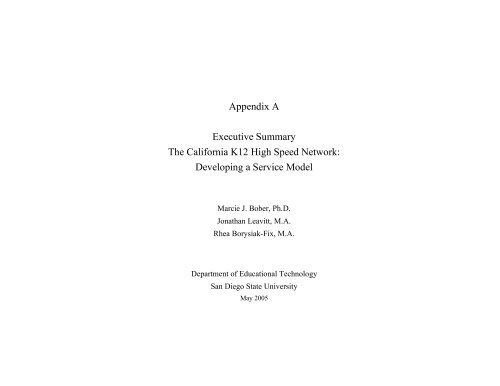
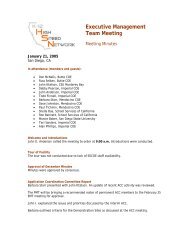
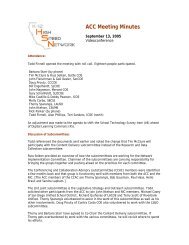

![Cyberbullying [K19, PRIV5] - Pew Internet & American Life Project](https://img.yumpu.com/23744339/1/190x245/cyberbullying-k19-priv5-pew-internet-american-life-project.jpg?quality=85)



